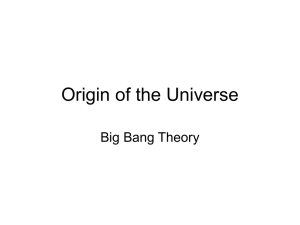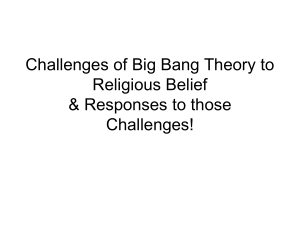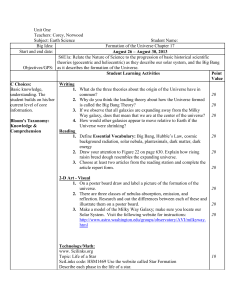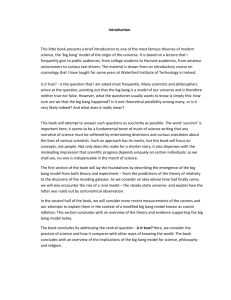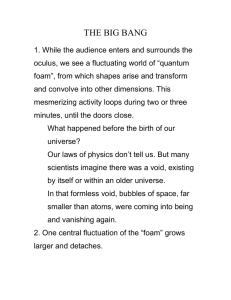Unit 4 Lecture Transcipts
advertisement
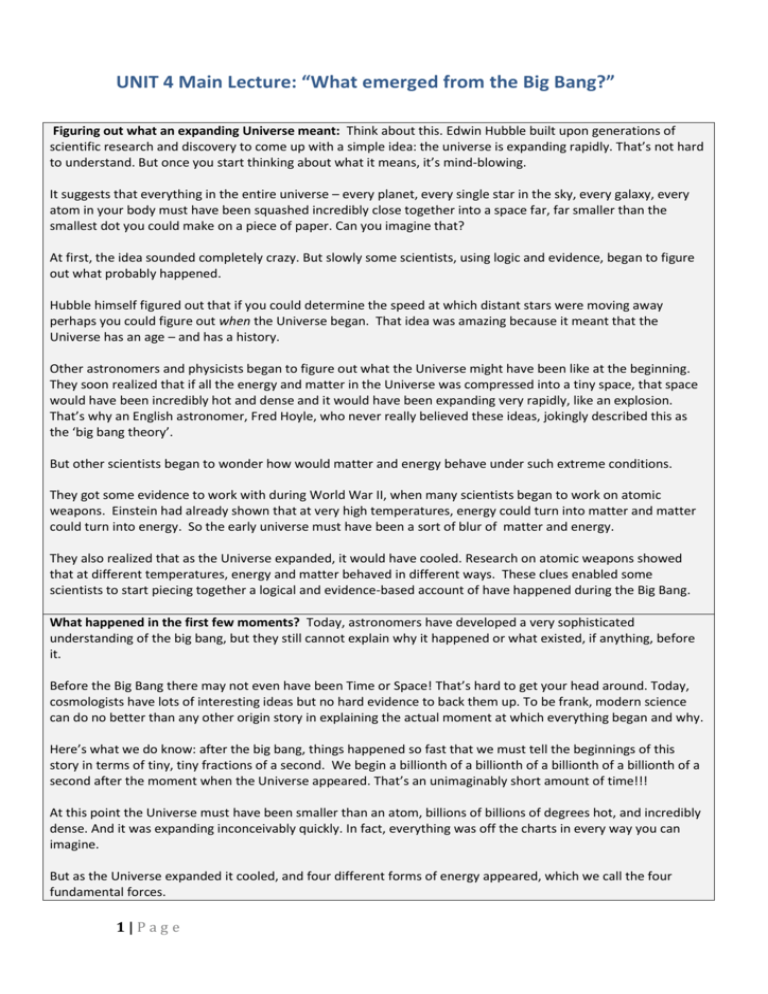
UNIT 4 Main Lecture: “What emerged from the Big Bang?” Figuring out what an expanding Universe meant: Think about this. Edwin Hubble built upon generations of scientific research and discovery to come up with a simple idea: the universe is expanding rapidly. That’s not hard to understand. But once you start thinking about what it means, it’s mind-blowing. It suggests that everything in the entire universe – every planet, every single star in the sky, every galaxy, every atom in your body must have been squashed incredibly close together into a space far, far smaller than the smallest dot you could make on a piece of paper. Can you imagine that? At first, the idea sounded completely crazy. But slowly some scientists, using logic and evidence, began to figure out what probably happened. Hubble himself figured out that if you could determine the speed at which distant stars were moving away perhaps you could figure out when the Universe began. That idea was amazing because it meant that the Universe has an age – and has a history. Other astronomers and physicists began to figure out what the Universe might have been like at the beginning. They soon realized that if all the energy and matter in the Universe was compressed into a tiny space, that space would have been incredibly hot and dense and it would have been expanding very rapidly, like an explosion. That’s why an English astronomer, Fred Hoyle, who never really believed these ideas, jokingly described this as the ‘big bang theory’. But other scientists began to wonder how would matter and energy behave under such extreme conditions. They got some evidence to work with during World War II, when many scientists began to work on atomic weapons. Einstein had already shown that at very high temperatures, energy could turn into matter and matter could turn into energy. So the early universe must have been a sort of blur of matter and energy. They also realized that as the Universe expanded, it would have cooled. Research on atomic weapons showed that at different temperatures, energy and matter behaved in different ways. These clues enabled some scientists to start piecing together a logical and evidence-based account of have happened during the Big Bang. What happened in the first few moments? Today, astronomers have developed a very sophisticated understanding of the big bang, but they still cannot explain why it happened or what existed, if anything, before it. Before the Big Bang there may not even have been Time or Space! That’s hard to get your head around. Today, cosmologists have lots of interesting ideas but no hard evidence to back them up. To be frank, modern science can do no better than any other origin story in explaining the actual moment at which everything began and why. Here’s what we do know: after the big bang, things happened so fast that we must tell the beginnings of this story in terms of tiny, tiny fractions of a second. We begin a billionth of a billionth of a billionth of a billionth of a second after the moment when the Universe appeared. That’s an unimaginably short amount of time!!! At this point the Universe must have been smaller than an atom, billions of billions of degrees hot, and incredibly dense. And it was expanding inconceivably quickly. In fact, everything was off the charts in every way you can imagine. But as the Universe expanded it cooled, and four different forms of energy appeared, which we call the four fundamental forces. 1|Page UNIT 4 Main Lecture: “What emerged from the Big Bang?” Within a few billionths of a billionth of a billionth of a second, gravity began to operate. Gravity is the force Newton identified, that exerts an attraction between every particle of matter and energy in the Universe. Then the electromagnetic force appeared; this comes in two charges, negative and positive. This is pretty familiar to us all in the form of electricity. Then came the strong and weak nuclear forces; these operate over tiny scales and bind the ‘nuclei’ of atoms together. Some energy congealed to form particles of matter. Energy is what makes things happen. Matter is the ‘stuff’ of the Universe, its basic constructional material. Quarks appeared. They were the first forms of matter, but with a split second they had joined in threes to form protons (which have positive electrical charges) and neutrons (which have no charge); these are the basic components of the nuclei that are at the center of all atoms. Then electrons appeared, which have negative charges. But the Universe was still too hot for protons and electrons to link up so matter took the form of “plasma”, a sort of sea of charged sub-atomic particles. One second after the big bang, the Universe had cooled to a mere 10 billion degrees, and it was about 100,000 times as dense as a piece of rock. Think about that. A scoop of the universe the size of a rock would have weighed as much as 25 elephants. So, what we’ve got now is a “plasma universe”. It lasted from a split-second after the big bang until around 380,000 years later. The plasma universe was filled with protons, neutrons, electrons and also photons. These are tiny packages of electromagnetism. And because this plasma was sparkling with electric charges, it acted a lot like Velcro, tangling up other particles like photons as they passed by. Notice how different this is from the Universe we all know today. Nothing more complex could form, no light could shine and there were no atoms. The Plasma Universe ended suddenly, and this ‘mini-threshold’ is important to our story for two reasons. First it marks the appearance of atoms, the basic matter necessary for creating just about everything else. Secondly, this change also gave scientists new evidence to support the big bang theory. Let’s look at the first reason why the ending of the Plasma Universe is important: the creation of atoms. By about 380,000 years after the big bang, the Universe had cooled to about 3,000 degrees, the temperature at the surface of cooler stars today. At this temperature, the electric charges of protons and electrons were powerful enough to link them up to form simple atoms. Because the positive charge of protons cancelled out the negative charge of electrons, matter changed its state; the charged plasma was replaced by vast clouds of electrically neutral atoms. The first atoms were of Hydrogen (with one proton and one electron) and Helium (with two protons and two electrons). In each atom the protons sit at the center in the ‘nucleus’, while the electrons, which have about 1/1,800th of the mass of a proton, whizz around at huge distances. Natalie Angier writes that “If the nucleus of an atom were a basketball located at the center of Earth, the electrons would be cherry pits whizzing about in the outermost layer of Earth’s atmosphere.” 2|Page UNIT 4 Main Lecture: “What emerged from the Big Bang?” Once atoms formed, photons could travel freely through the universe because there were no electric charges to entangle them. Remember, the positive charges of protons cancelled out most of the negative charges of electrons. And this leads to our second reason why the ending of the Plasma Universe was important: this transition left a major clue that the big bang theory was on the right track. Evidence? Astronomers had worked out as early as the 1940s that when the first atoms formed, all the photons in the Universe would suddenly be released in a huge flash of energy. They pointed out that we ought to be able to detect that energy, but strangely, no one went looking for it, a sign, perhaps, that most astronomers did not take the idea of a ‘big bang’ too seriously. Then, in 1963, two astronomers stumbled upon it by accident. Arno Penzias and Robert Wilson were trying to build an extremely sensitive radio receiver. To their frustration, they could not get rid of a persistent hiss of energy that seemed to come from everywhere. Energy coming from a particular star or galaxy made sense, but this seemed to make no sense because the energy was coming from everywhere. Then they realized this was the flash of energy that had been predicted back in the 1940s. Today this energy is known as ‘Cosmic Background Radiation’ or CBR. This was extremely good evidence for the claims of big bang theory because it supported ideas that many scientists in the 1940s viewed as too bizarre to be true, and also because the CBR couldn’t be explained by any other theory. Now most astronomers were convinced. Since then, much more evidence has emerged, but Hubble’s findings and the discovery of the CBR are probably the strongest reasons for trusting the claims of big bang cosmology. We see this often – someone develops a creative claim that challenges established ways of thinking, but lacks enough evidence to convince others. People reject their ideas. Then, years later, when new evidence emerges, they come in from the cold and their ideas are accepted. Their ideas then become established as the new way of thinking. The first threshold: creating the building blocks of the Universe: Consider how amazing we humans are. Building upon each other’s ideas, we collectively figured out the history of events that happened not 10 years ago, not 100 years ago, not 10,000 years ago, but 13.7 billion years ago. The Big Bang created the fundamental building blocks for everything that exists around us: the energy and the matter that make our earth and you and me. Their creation in the Big Bang counts as the first major threshold in our course, the first step towards the creation of more complex things. After all, something (a Universe!) is surely more complex than nothing (what existed before the Universe existed). In the next unit we will cross a second threshold of complexity, as we see how the first stars emerged. 3|Page

